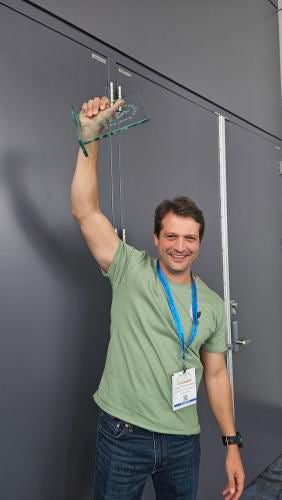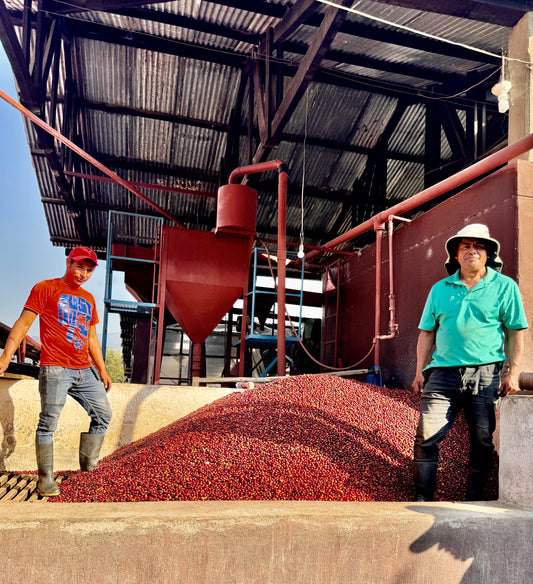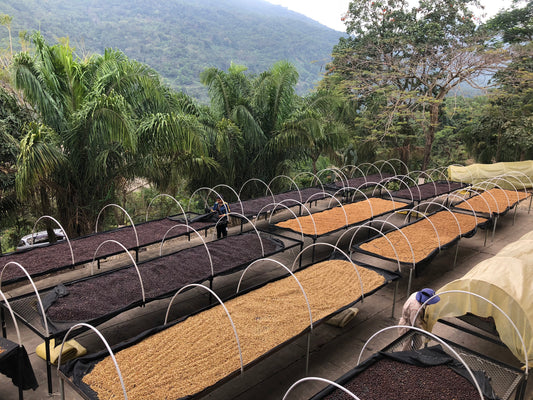Guatemalan Montecristo - Coffee Buying Trip

We have been buying direct trade coffee since 2013, which means we have years of experience in understanding the best practices in coffee production and purchase. We go to Guatemala once a year to learn more about our producers and their families, to understand their challenges, and to stay up-to-date on their successes
On January 17th my brother’s Jason & Chris joined my self to travel to Guatemala to visit our friend Johann Nottebohm and his wife Holly at their farm Nueva Granada. Our journey began in Guatemala City when we traveled 7.5 hours by car to the far North West corner of Guatemala which is known as the San Marcos region.

Johann’s is now the 3rd generation coffee farmer in the Nottebohm family. His great grandfather, originally from Germany, moved to Guatemala in 1894. Nueva Granda was the 3rd farm in Guatemala to become Rainforest Alliance certified, and their family tradition continues today of striving for better quality, consistency, improving environmental techniques and educating the families that live on their farm.
The pride in this farm is shown on every level. It starts by watching their team pick only the ripest red cherries. Every 2 weeks, each tree will have hands sort through their branches choosing the best coffee, for a total of 15 passes per harvest! Most farms will only have 4 or 5 passes per harvest forcing them to choose over & under ripen cherries each time.
Once picked, cherries are brought immediately to the wet mill located on the farm. When loading the cherries, they pass through TWO floating stations to pull out less dense, lower quality beans. After removing the fruit, the coffee is put into fermentation tanks where it sits for 24-36 hours. Once ready, the mucilage is removed, and the beans pass through a THIRD floating station to again sort any defected beans. The good beans again sit over night in fermentation tanks to ensure the cleanliness of the product.
Coffee is then sun & machine dried, and fed into two density sorting machines to sort out the highest quality coffee for export. To our delight, hand sorting stations are then used to pull out any defected beans that have not already been found. If this wasn’t enough, a color scanner is being installed that will separate any fermented and off colored beans that may not been seen by site.

COMMUNITY PRACTICES:
Johann also is in the process of building a new school on the farm that will separate grades 8-10 from grades 1-6. They currently have 45 students, but this number will grow during the harvest season. 19 families live full time on the farm and a total of 240 people. Johann ensures that their standard of lives are comfortable through bring doctors to the farm regularly, employees 3 teachers (1 computer teacher), has a church and a small market to shop at. To top it off, all health care, food and transportation is also paid for by Johann for his staff.

ENVIORNMENTAL PRACTICES:
Being Rainforest Alliance ensures that Nueva Granda is practicing good environmental techniques. Some of what involves Johann choosing to:
- Reuse 100% of the coffee cherries as organic fertilizer
- Collection Honey Water from the Fermentation tanks in a storage area to dry up the water. They then scrap off the residue to use as fertilizer.
- Have started worm farms, to use their manure as fertilizer.
- Uses the hauls from the shading Macadamia nuts as fertilizer.
- Protects wildlife through not clear cutting and deforestation products.
- Protects the river systems through properly handling by products of the wet mill.
Needless to say, the taste in the cup shows their efforts!! We hope to introduce you to a new Micro Region of their farm later this year. Montecristo sits at a staggering 5200 feet (the highest farm in San Marcos) which grows 100% Bourbon. This coffee is super clean and soft with a buttery body. When cupping this coffee we found juicy complex fruit notes that we will pull out during our roasting process. We are thrilled to have a Direct Trade partnership with Nueva Granada and know you will enjoy this coffee as much as we do.



